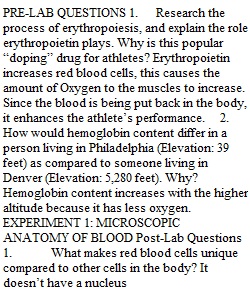


Q Lab Report 2: Blood and Heart Experiment 3 – Microscopic Anatomy of Blood (36 points) © 2013 eScience Labs, LLC. All rights reserved. Instructions: Answer the following questions in complete sentences using correct grammar, spelling, and terminology. 1. What makes red blood cells unique, compared to other cells in the body? 2. How is new blood made? 3. What is the main function of platelets? 4. Describe how the body stops bleeding. 5. Sickle cells are named so because of their characteristic shape. What problems can this cause? 6. Explain how the absence of a nucleus affects the RBC’s life span. Experiment 4: Blood Typing Experiment (64 points) © 2013 eScience Labs, LLC. All rights reserved. Instructions: Enter your experimental data into Table 4 below. Take a picture of your experiment after your last measurement at two minutes and include your photograph in your lab report. Table 4: Blood Typing Results A (Blood Sample A) B (Blood Sample B) C (Blood Sample C) 1 (Anti-A Serum) 2 (Anti-B Serum) 3 (Anti-Rh Serum) Blood Type: Attach Image 1: Labeled 12-Well Plate with Mixed Blood Sample and Typing Sera Instructions: Answer the following questions in complete sentences using correct grammar, spelling, and terminology. 1. What determines blood type? 2. What type of blood antigens are expressed if a person is AB-? 3. Why doesn’t a negative transfusion reaction occur the first time a Rh positive person is exposed to negative blood.
View Related Questions